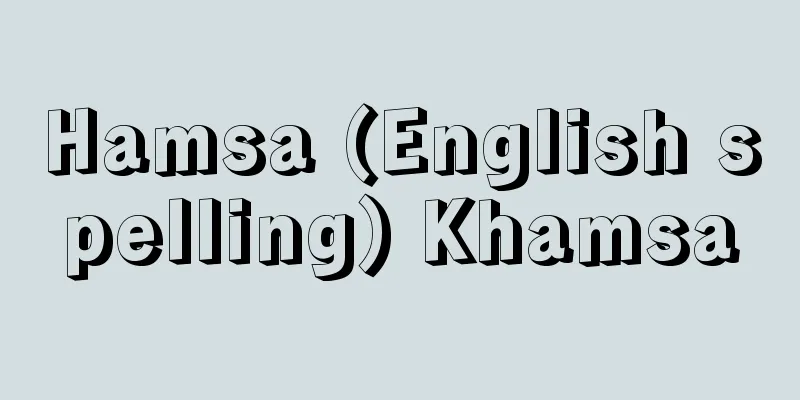Disarmament

|
Disarmament (disarmament) is said to be a translation of the French word désarmement and the English word disarmament, but they are not strictly the same. Disarmament was originally used to mean disarmament of individuals, armies, military vessels, military fortresses, etc., and originally meant the substantial removal, dismantling, and disposal of military equipment. In modern Europe, this word has gradually come to mean the disarmament of defeated countries, as well as the abolition of national military equipment through agreements between countries, but in this case too, it meant a high level of denial and abolition of military equipment aimed at preventing war. In modern times, disarmament has deviated from the original idea of disarmament and is often used to mean a slight reduction or reduction of each country's military equipment based on international agreements. Furthermore, when talking about disarmament issues, it includes the reduction or reduction of military equipment, but it is used as a comprehensive term that includes many related measures that do not reach that level. It should be noted that it also includes ideas different from disarmament, which will be discussed later. [Nakae Masatsugu] The idea of disarmamentThe idea of disarmament developed in earnest in Europe from the 18th century onwards. In Europe during this period, the formation of powerful unified nations, the advancement of weapons technology after the Industrial Revolution, and the organization of national armies after the Civil War led to a qualitative change in the scale and nature of wars from the private battles between kings and nobles that had been fought mainly by mercenaries. For this reason, the idea of disarmament was aimed above all at preventing or limiting wars by taking away the means of war. In the second half of the 18th century, thinkers such as Bentham in England and Kant in Germany published detailed European peace plans, each of which had as its central idea a drastic reduction in standing armies. Since then, disarmament has been repeatedly emphasized, especially after major wars. However, in reality, disarmament has never been achieved with the effect of preventing or limiting war, as its original aim. What developed in the 19th century to regulate armaments were the laws of warfare (known today as international humanitarian law), which did not reject war but restricted the ways and means of warfare from a humanitarian perspective. For example, the prohibition of the use of poison gas (and the prohibition of chemical weapons, which then led to disarmament) are ideas of this type. Another idea that gained strength in the United States in the 1950s was that after World War II, especially in the nuclear age, maintaining peace depends on the balance of arms (nuclear deterrence system), so it is not desirable to disarm without due consideration, and that control measures to stabilize the balance of power should be considered. This idea was called "arms control" to distinguish it from disarmament, but this is an idea that does not matter whether armaments are reduced or increased as long as they are measures that contribute to stabilizing the situation, such as the strategic arms limitation between the United States and the Soviet Union. In general, disarmament or disarmament issues are often used to refer to a comprehensive range of measures based on various real-life ideas, while aiming at disarmament. When considering disarmament, it is important to understand that there is a difference between the original idea of disarmament and the various real-life related measures. [Nakae Masatsugu] Disarmament until World War IIn the 19th century, proposals for reducing armed forces and limiting military armaments were made among the great powers in Europe. These included a proposal from Imperial Russia to Britain in 1816 under the Vienna System after the Napoleonic Wars, a proposal from France to European countries after the July Revolution in Paris (1831), three proposals by Napoleon III after 1863, and a proposal from Britain to Prussia just before the Franco-Prussian War (1870). However, none of these proposals progressed to the stage of concrete negotiations. One of the achievements of this period was the Rush–Bagot Agreement, which was negotiated by an exchange of notes on April 28 and 29, 1817, between Britain and the United States, which had ended their war with the Treaty of Ghent in 1814. This agreement was a localized agreement that limited the number, type, and equipment of ships in the navies of both countries on the Great Lakes, Lake Champlain, and on the US-Canada border south of Montreal. In 1898, N. Muravyov, the foreign minister of Imperial Russia, sent a circular to the nations proposing an international peace conference. Based on this, the first Hague Peace Conference (26 countries participated) was held on May 18, 1899, and the second (44 countries participated) was held on June 15, 1907. However, this conference only passed a resolution to the effect that arms control and reduction in military expenditures, which were the intended objectives of the conference, were desirable. Rather, it was notable for its achievements in the area of international law of war (laws of warfare), which is different from disarmament, such as the prohibition of dropping bombs from the air and the use of poison gas. [Nakae Masatsugu] Disarmament during the Interwar PeriodThe League of Nations, established after World War I, stipulated in Article 8 of its Covenant that member states, in order to maintain peace, would reduce their armaments to the minimum necessary so as not to impede national security and the common fulfillment of international obligations. Peace treaties, such as the Treaty of Versailles, which included this Covenant as its first article, stipulated strict restrictions on the land, navy, and air forces and their equipment of the defeated nations, especially Germany (Article 159 and following of the Treaty of Versailles), and these restrictions on German armaments were the prerequisite for the general disarmament project under Article 8 of the Covenant, which was to be implemented at some point. The League Council deliberated in the Permanent Military Advisory Committee, which it established on May 19, 1920, based on Article 9 of the Covenant (Permanent Military Committee), and then, from 1926, the Preparatory Committee for the Disarmament Conference, which was established at the end of the previous year, continued to collect the opinions of the nations. When the preparatory committee reached a tentative agreement with some reservations from each country, the League Council resolved to convene a disarmament conference on January 24, 1931, and the conference was held in Geneva on February 2, 1932 with the participation of 59 countries. However, the main obstacle to the discussion was the conflict between Germany, which wanted to overturn the status quo in Europe (the so-called Versailles system), and France, which felt the threat of German rearmament more strongly than anyone else, and the deliberations were extremely difficult. The always-present question of "Should disarmament or security come first?" was a circular question. In 1933, Hitler took power and began rearmament, which meant that the premise for the League's disarmament project was lost, and the disarmament conference was not held again after the end of 1934 without reaching a concrete agreement. Although the League of Nations failed to achieve general disarmament, some agreements were concluded between specific countries during this period. One was the Washington Naval Arms Limitation Treaty, signed on February 6, 1922 by the United States, Great Britain, Japan, France, and Italy. This treaty determined that the ratio of capital ships owned by the five major naval powers was 5 for the United States, 5 for the United Kingdom, 3 for Japan, 1.67 for France, and 1.67 for Italy. The United States and Great Britain felt the need to put a stop to the expansion of Japan's military, which had emerged as a naval power in the Asia-Pacific region after World War I. On the other hand, Japan, as an emerging naval power, had embarked on the construction of a large navy, but faced difficulties such as financial pressure and shortages of materials. Although there were complaints about the inequality, they accepted the treaty for the time being. Financial difficulties are always an important factor that leads to disarmament. This treaty was also established as part of the so-called "Washington System," which consisted of numerous treaties, agreements, and protocols that were concluded at the same time. It is difficult to imagine that disarmament could be realized independently, apart from the political situation. After that, talks were held on limiting auxiliary vessels, namely cruisers, destroyers, and submarines, which had not been agreed upon at the Washington Conference. First, at the suggestion of the US President, a tripartite conference was held in Geneva in June 1927 between the US, the UK, and Japan (France and Italy refused to participate). However, the US-UK conflict could not be resolved and no agreement was reached. Then, in January 1930, a five-power conference was held in London, this time with France and Italy participating, and on April 22, 1930, the London Naval Arms Limitation Treaty was signed. However, France and Italy could not reach an agreement and did not join the treaty. This treaty determined that the number of auxiliary vessels possessed by Japan would be 70% of those of the US and UK for small cruisers, and equal for submarines, with the condition that the number of large cruisers would be 60% of those of the US and UK. However, Japan, which had begun to adopt an expansionist policy, notified Japan as early as December 1934 that it would abolish the Washington Naval Arms Limitation Treaty at the end of 1936. The London Naval Arms Limitation Treaty also expired at the end of 1936 due to the breakdown of the tripartite conference (London) held in 1935 between the United States, Britain, and Japan based on Article 23 of the treaty. The Anglo-German Naval Agreement concluded during this time was an agreement that amended the Treaty of Versailles to officially allow Germany to possess naval power up to 35% of Britain's, but was not a disarmament treaty. Thus, from 1937 onwards, a naval arms race between the major powers was once again waged in a treaty-free state. [Nakae Masatsugu] Disarmament after World War IIArticle 26 of the United Nations Charter stipulates that the Security Council shall establish a system of "regulation of arms" "with a view to promoting the establishment and maintenance of international peace and security with the least diversion of the world's human and economic resources for armaments." However, the UN had to address the issue of nuclear weapons, which was not anticipated in this disarmament provision, immediately after its inception, and so in 1946 the UN Atomic Energy Commission was established. The following year, the UN Committee on Conventional Arms was established, and these two forums deliberated issues such as the international control of atomic energy, the prohibition of atomic (nuclear) weapons, and the reduction of conventional arms. However, after it became clear in 1949 that the Soviet Union possessed atomic bombs, it became meaningless to deliberate nuclear weapons and conventional arms separately, so in January 1952 the two previous committees were merged into the Disarmament Committee, and in April 1954, with an emphasis on discussions between major powers, a five-nation subcommittee consisting of the United States, the Soviet Union, the United Kingdom, France, and Canada was established under the same committee. There was lively discussion of general disarmament in line with Article 26 of the Charter and the formulation of a phased programme for comprehensive disarmament, but no agreement was reached and disarmament talks of this nature petered out in the mid-1950s. The focus of the negotiations gradually shifted to so-called partial measures related to nuclear armaments that did not directly aim at disarmament. As the nuclear arsenals of both the United States and the Soviet Union were increasing, there was no prospect of major disarmament, and at the same time, a "nuclear stalemate" occurred in which neither side could easily resort to war due to the possibility of large-scale retaliation from the other side, and it became necessary to think about stabilizing the situation. The agenda of the negotiations was aligned with the interests of the superpowers, the United States and the Soviet Union, and accordingly the negotiating body was the Ten-Party Disarmament Committee (March 1960), which was attended by an equal number of countries from the East and West alliances, namely the North Atlantic Treaty Organization (NATO) and the Warsaw Pact (WTO), and was located outside the United Nations (Geneva). This negotiating body continued to expand and be reorganized, including by adding non-aligned countries, and in 1984 it was renamed the current Conference on Disarmament (65 countries since 1999), which continues to exist today. [Nakae Masatsugu] Disarmament during the Cold WarThe first important disarmament-related agreement after World War II was the Partial Test Ban Treaty (PTBT), signed by the United States, the United Kingdom, and the Soviet Union the year after the Cuban Missile Crisis (1962) and open to all countries. This treaty banned nuclear weapons testing except for underground tests, but more important than its provisions was its political significance in that it created rules for partial coexistence between the United States and the Soviet Union in the midst of the harsh Cold War against the backdrop of a nuclear stalemate. This treaty triggered the establishment of many bilateral and multilateral agreements during the so-called detente period of the 1970s. In terms of content, they can be roughly divided into the following categories. First, there were those that were intended to complement the nuclear deterrence system of the United States and the Soviet Union and to avoid nuclear war, such as the Anti-Ballistic Missile System Limitation Treaty (ABM Treaty, signed in 1972) and the Strategic Arms Limitation Agreement I (SALT-I, signed in 1972). The second type of treaty is the Treaty on the Non-Proliferation of Nuclear Weapons (NPT), which was signed in 1968, and the Treaty on the Non-Proliferation of Nuclear Weapons (PTBT). The third type is the Treaty on the Prevention of Nuclear Weapons and Proliferation of Nuclear Weapons (PTBT), which was signed in 1968, and the Treaty on the Non-Proliferation of Nuclear Weapons (NPT), which was signed in 1968. The third type of treaty ...PTBT), which was signed in 1968. The third type of treaty is the Treaty on the Non-Proliferation of Nuclear Weapons (PTBT), which was signed in 1968, and the Treaty on the Non-Proliferation of Nuclear Weapons (PTBT), which was signed in 1968. The third type of treaty is the Treaty on the Non-Proliferation of Nuclear Weapons (PTBT), which was signed in 1968, and the Treaty on the Non-Proliferation of Nuclear Weapons (PTBT), which was signed in 1968. The third type of treaty is the Treaty on the Non-Proliferation of Nuclear Weapons (PTBT), which was signed in 1968, and the Treaty on the Furthermore, the non-aligned countries, dissatisfied with the delay in nuclear disarmament under this system, called for the convening of a special session of the UN General Assembly on disarmament, attended by all UN member states. This conference was held three times since 1978 (1982, 1988), but because of the bitter conflict between the non-aligned countries and the nuclear-weapon states, it did not produce any concrete results, although it did arouse international public opinion in favor of disarmament. [Nakae Masatsugu] End of the Cold War and DisarmamentThe next time disarmament negotiations began to progress was after the late 1980s, towards the end of the Cold War and after the Cold War. First, regarding the regulation of nuclear forces, the Intermediate-Range Nuclear Forces (INF) Treaty was signed in December 1987. This was against the backdrop of Gorbachev's active support for disarmament after he became General Secretary of the Communist Party of the Soviet Union in 1985 and launched Perestroika. This treaty was the first disarmament treaty since the war to completely eliminate medium-range and intermediate-range missiles with ranges of 500 to 5,500 kilometers not only in Europe but also in Asia, and it was the first disarmament treaty to eliminate approximately 2,500 missiles in total between the United States and the Soviet Union. From the negotiations that succeeded the Cold War-era SALT, the Strategic Arms Reduction Treaty (START-I) was signed in 1991. This also became a disarmament treaty reflecting the fact that the nuclear arms race had become meaningless with the end of the Cold War. However, after the treaty was signed, the Soviet Union collapsed, and the strategic nuclear forces deployed in Belarus, Ukraine, and Kazakhstan were transferred to Russia, and these three countries were required to sign the Lisbon Protocol to join the NPT as non-nuclear weapon states, and START-I did not come into effect until 1994. Under this treaty, the United States was to reduce the number of missiles by 29% and the Soviet Union by 36%, and both were to reduce their warheads by just over 40% over the seven years following its entry into force. Amid this growing momentum for disarmament, U.S. President G. H. W. Bush announced in September 1991 that the United States would unilaterally remove most of its tactical nuclear weapons deployed overseas, both on land and at sea, and President Gorbachev responded by proposing a more thorough reduction in tactical nuclear weapons. During this time, the START-II Treaty was signed in 1993, which called for a further reduction in the number of warheads from START-I to about half (3,000-3,500) by 2003, but it did not come into force due to growing conflict between the United States and Russia over the perception of the post-Cold War situation, particularly over missile defense. The administration of George W. Bush in the United States, which took office in 2001, pursued the War on Terrorism and showed no strong interest in arms reduction. At the end of 2001, Bush unilaterally withdrew from the ABM Limitation Treaty, which was an obstacle to the deployment of missile defense (MD) systems. In 2002, the United States signed the Strategic Offensive Reductions Treaty (SORT) with Russia, but this had little meaning in terms of arms reduction. The Obama administration (2009- ) attempted to break the stagnation of arms reduction during the Bush era. Obama quickly set forth his goal of a "nuclear-free world," and in April 2010 signed the New START Treaty, which reduced strategic nuclear warheads to 1,550, more than 80% from the peak in the 1980s. This treaty was the successor to START-I, which expired and became ineffective in 2009. The establishment of a disarmament treaty for conventional forces in Europe, amid the growing momentum for arms reduction after the INF Treaty, was the first new development since the end of the Cold War. In 1989, the Mutual Arms Reduction Talks in Central Europe (MRFA or MBFR), which had not produced any results, was terminated, and the new negotiations on conventional forces in Europe were started by 23 NATO and WTO member countries under the framework of the Conference on Security and Cooperation in Europe (CSCE, 35 countries). In 1990, the Treaty on Conventional Forces in Europe (CFE), which reduced conventional forces by 23%, was agreed upon and signed, and shortly thereafter the Soviet Union collapsed, and the contents were revised and the treaty came into effect in 1992 among 30 countries, including newly independent countries. However, the situation changed after that, with former Warsaw Pact member countries joining NATO one after another, and the treaty was amended to the adapted CFE Treaty and signed in 1999, but Russia and NATO were at odds over several regional power imbalances, and the adapted CFE Treaty has not come into effect. Secondly, the issue of banning nuclear testing and non-proliferation has become even more difficult since the end of the Cold War. Inspections after the Gulf War in 1991 revealed that Iraq had begun developing not only nuclear weapons but also chemical and biological weapons. At the same time, suspicions of North Korea's nuclear development arose, and there were fears that this would continue with Libya, Iran, Syria, and so on. The problem is not limited to nuclear proliferation, but has now expanded to the proliferation of weapons of mass destruction (WMD). The countries of concern have shifted from developed countries with the technical capabilities and funds that were of concern when the NPT was established to somewhat unique developing countries with security issues, and since as NPT member countries they uphold the right to peaceful uses, they are countries that are difficult to deal with within the system. First, in 1993, an agreement was reached on the Chemical Weapons Convention, which had been a remaining issue after the establishment of the Biological Weapons Convention (1972), one of the weapons of mass destruction. This treaty stipulates the complete elimination of chemical weapons, and also provides for surprise inspections and sanctions to ensure their implementation. Although abolishing them requires a large amount of money and complete elimination will take time, it is an important disarmament treaty that developed from the laws of warfare. Regarding nuclear proliferation, the NPT was extended indefinitely at the NPT Review and Extension Conference in 1995. The Comprehensive Nuclear-Test-Ban Treaty (CTBT), included in the document adopted at the same time, failed to reach a consensus at the Geneva Disarmament Conference the following year in 1996 due to India's opposition, but was adopted as a UN General Assembly resolution in the same year and opened for signature. Its entry into force requires ratification by all 44 countries, including India, Pakistan, Israel, North Korea, Iran and other nations believed to have nuclear development capability, so there is no prospect of it coming into force. Thirdly, the movement to create nuclear-free zones in certain regions became more active after the Cold War. The South Pacific Nuclear-Free Zone Treaty, adopted in 1985, provided impetus for other nuclear-free zone treaties to be established in Africa (adopted in 1995), Southeast Asia (signed in 1995), and Central Asia (signed in 2006). This shows that the motivation has expanded beyond disarmament issues, from a simple desire to avoid being caught up in a nuclear war between East and West, as was the case during the Cold War, to a ban on nuclear testing, a ban on the dumping of radioactive waste, and the removal of radioactive contamination, which overlap with environmental concerns. Finally, one of the characteristics of disarmament since the end of the Cold War is the growing movement towards the formation of a humanitarian regime. This originally developed from the genealogy of the four Geneva Conventions (international humanitarian law), and includes the Protocol to the Convention on Certain Conventional Weapons (CCW) adopted in 1980 (restricting and prohibiting the use of landmines, booby traps, incendiary munitions, etc.), and the revised Protocol (1996) which allows Protocol II on landmines to be applied to civil wars and undetectable mines. However, there are differences in the formation of new treaties after the Cold War. The characteristics are, first, that the safety of individual people is emphasized over the security between nations, and that the protection and relief of victims is considered from a humanitarian perspective; second, unlike the previous laws of warfare or international humanitarian law, not only is the use restricted or prohibited, but production, storage and use are completely prohibited; and lastly, rather than a formal negotiating body between nations, like-minded countries are taking the lead and working with non-state actors (NGOs) to draft and bring into force the treaty as soon as possible. Examples of this type of treaty include the Convention on the Prohibition of Anti-Personnel Mines, signed in 1997, and the Convention on Cluster Munitions, signed in 2008. Treaties by willing nations have some weaknesses, such as the lack of participation by major producers and users of small arms, but they show a new trend in disarmament after the Cold War. Small arms are a different type of weapon, but they are also being regulated for the same humanitarian reasons in the post-Cold War situation of frequent civil wars. However, there are no treaties or binding systems on this issue. Willing nations such as Japan and NGOs are conducting international awareness-raising activities and are strengthening the implementation of the "Plan of Action" formulated by the UN Conference. The development of methods to track the illegal inflow of small arms, international cooperation in regulating the intermediation of illegal trade, and strengthening the collection and destruction of weapons in peacebuilding after civil wars are the most important activities. Thus, the period after World War II is a unique one in the long history of international politics, in terms of the number of disarmament and related agreements. One reason is the anxiety of the nuclear age. Industrial warfare reached its peak in the two world wars, and the development of nuclear weapons made large-scale wars difficult. However, these were extremely unstable, supported by nuclear deterrence, and therefore it was necessary to constantly confirm each other's intentions through treaties and other agreements while relying on nuclear deterrence. The large number of treaties reflected this anxious era. Secondly, after the war, the use of force was generally prohibited by the UN Charter. However, as colonies gained independence one after another, there were still many situations in each country and region where it was necessary to respond with force, but during the Cold War, disarmament in such unstable regions was not given much importance. However, gradually, in areas where it was possible, efforts were made to expand frameworks for confidence building and dialogue to resolve conflicts without using force, which became one of the reasons for the high interest in disarmament. Finally, among the countries that gained independence from their colonies after the war, there were nations that were economically exhausted and politically unstable after independence. Among these countries, some struggled with repeated civil wars around the time of the end of the Cold War, making it difficult to rebuild their societies and nations. In these circumstances, a new approach was introduced, based on a humanitarian perspective that differed from the traditional approach of national security, such as banning certain weapons with a strong inhumane nature, or "micro-disarmament" of small arms. Disarmament is originally intended to prevent war. The end of the Cold War brought about a dramatic change in the situation, and disarmament-related measures became significantly more diverse. Although it is essential to devise a variety of measures flexibly according to the circumstances of each country and region, it has become even more important not to lose sight of the goal of disarmament. [Nakae Masatsugu] "History of Disarmament Negotiations" by Maeda Hisashi (1968, University of Tokyo Press)" ▽ "International Disarmament Issues" by Saegusa Shigetomo, reprint edition (1975, Hara Shobo)" ▽ "Disarmament Issues" by Maeda Hisashi (included in International Studies, edited by Mushanokoji Kinhide and Royama Michio, 1976, University of Tokyo Press)" ▽ "Disarmament Treaties: A Collection of Documents" edited by Fujita Hisakazu and Asada Masahiko (2nd edition 1997, 3rd edition 2009, Yushindo Kobunsha)" ▽ "Introduction to Disarmament " edited by Kurosawa Mitsuru, new edition (2005, Toshindo)" ▽ "Law and Politics of Nuclear Disarmament and Non-Proliferation" edited by Asada Masahiko and Tosaki Hiroshi (2008, Shinzansha Publishing) [References] | | | | | | | |Source: Shogakukan Encyclopedia Nipponica About Encyclopedia Nipponica Information | Legend |
|
軍縮(軍備縮小)は、フランス語のdésarmement、英語のdisarmamentの訳語とされるが、厳密には一致していない。disarmamentは、もともと個人や軍隊、軍用艦船、軍事要塞(ようさい)などの武装解除の意味に用いられ、本来かなり実質的な軍備の撤去、解体、廃棄などをさしていた。近代以降のヨーロッパで、この語はしだいに敗戦国の武装解除のほか、国家間の取決めなどによる国家軍備の撤廃の意味に使われるようになってきたが、この場合も戦争防止を目ざす程度の高い軍備否定・撤廃を意味した。現代では軍縮は、こうしたもともとの軍縮思想からずれて、主として国際的な取決めに基づく各国軍備の多少の縮小、削減の意味で使われることが多い。さらに軍縮問題などという場合は、軍備の縮小や削減も含むが、それに至らない多くの関連諸措置を含む包括的な呼称として使われている。そこには後述する軍縮とは異なる考え方も含まれているので注意が必要である。 [納家政嗣] 軍縮の思想軍縮の考え方が本格的に発展したのは、18世紀以降のヨーロッパにおいてであった。この時期のヨーロッパでは、強力な統一国家の形成、産業革命後の兵器技術の進歩、さらに市民革命後の国民軍の組織化などが進み、それが戦争の規模や様相をそれ以前の傭兵(ようへい)を中心とする王侯貴族間の私的な戦闘とは質的に異なるものにした。このため、軍縮思想は、なによりも戦争の手段を奪うことによって戦争を防止したり、制限したりすることを目的とする考え方であった。18世紀後半には、イギリスのベンサムやドイツのカントら思想家が、詳細なヨーロッパの平和計画Peace Planを発表したが、いずれもこのような常備軍の大幅な縮小構想を一つの中心としていた。以来、軍縮は今日に至るまで、とくに大戦争のあとなどに繰り返し強調されている。しかし、現実には本来のねらいとした戦争を防止、制限するほどの効果をもつ軍縮は実現したことがない。軍備の規制で19世紀に発展したのは、むしろ戦争を否定するのではなく人道的な観点から戦い方や戦争の手段を制限する交戦法規(現代では国際人道法)であった。たとえば毒ガスの使用禁止(そこから軍縮へ発展した化学兵器の禁止)などが、この系統の考え方である。もう一つ、第二次世界大戦後、とくに核時代になって平和の維持は軍備の均衡(核抑止体制)によるのでむやみに軍縮するのは好ましくない、むしろ勢力均衡を安定させるための管理措置を考えるべきであるとの考えが、1950年代のアメリカで強まった。このような考え方は軍縮と区別する意味で「軍備管理arms control」とよばれたが、これは米ソの戦略兵器制限のように情勢の安定に役だつ措置であれば、軍備を縮小するか増強するかは問わない考え方である。現代では一般的に軍縮、あるいは軍縮問題という場合には、軍縮を目標としつつも、現実の多様な考え方にたつ措置を包括的にさすものとして使われることが多い。軍縮を考えるうえで、本来の軍縮思想と現実のさまざまな関連措置の間に違いがあることを理解することは重要である。 [納家政嗣] 第一次世界大戦までの軍縮19世紀のヨーロッパでは列強の間で武装兵力削減や軍備制限の提案が行われた。ナポレオン戦争後のウィーン体制の下での1816年帝政ロシアからイギリスへの提案、パリ七月革命後のフランスからヨーロッパ各国への提案(1831)、1863年以降のナポレオン3世による3回の提案、普仏戦争直前にイギリスがプロシアに対して行った提案(1870)などである。しかしこれらの提案はいずれも具体的な交渉の段階には進まなかった。この時期の成果としては、1814年にガン条約で戦争を終結していたイギリスとアメリカが、1817年4月28、29日の交換公文で取り決めたラッシュ・バゴット協定などがある。この協定は五大湖とシャンプレーン湖、モントリオール南方の米加国境における両国海軍の隻数、艦型、装備などを制限した局地的な取決めであった。 1898年帝政ロシアの外相N・ムラビヨフは列国に回状を送って、国際平和会議を提案した。これに基づいて、1899年5月18日に第1回(26か国参加)、また1907年6月15日に第2回(44か国参加)のハーグ平和会議が開催された。しかし、この会議も目的としていた軍備制限や軍事費削減については、これが望ましい旨の決議を行うにとどまった。むしろ爆弾の空中からの投下や毒ガスの禁止など、軍縮とは異なる戦時国際法(交戦法規)の面での成果が目だった。 [納家政嗣] 戦間期の軍縮第一次世界大戦後に設立された国際連盟は、その規約第8条で、加盟国は平和維持のために、その軍備を国の安全と国際義務の共同遂行に支障のない最低限度まで縮小することを規定した。この規約を第1編として含むベルサイユ条約など各講和条約は、敗戦国、とくにドイツの陸海空軍およびその装備の厳重な制限を規定していたが(ベルサイユ条約第159条以下)、この対独軍備制限がいずれ実施されるはずの規約第8条による全般的な軍縮事業の前提になっていたわけである。連盟理事会は、規約第9条(常設軍事委員会)に基づいて1920年5月19日に設置した常設軍事諮問委員会で審議を行い、その後1926年からは前年末に設置された軍縮会議準備委員会で各国の意見の取りまとめを続けた。準備委員会の討議が各国の留保条件つきながらいちおうの合意に達したところで、連盟理事会は、1931年1月24日軍縮会議の招集を決議し、同会議は翌1932年2月2日から、59か国の参加を得てジュネーブで開催された(ジュネーブ軍縮会議)。しかし、ヨーロッパの現状(いわゆるベルサイユ体制)打破を志向するドイツと、ドイツ再軍備の脅威をひときわ強く感じるフランスの対立が主たる障害となって、審議は難航を極めた。軍縮にいつでも付きまとう「軍縮が先か、安全保障が先か」の堂々巡りであった。1933年に入るとヒトラーが政権を掌握し、再軍備に乗り出したため、連盟による軍縮事業の前提が失われることとなり、軍縮会議は具体的な合意に至ることができないままに、1934年末以降はふたたび開かれなかった。 国際連盟による全般的な軍縮は失敗したが、この時期にはいくつかの特定国間の取決めが成立した。一つは、1922年2月6日にアメリカ、イギリス、日本、フランス、イタリアが調印したワシントン海軍軍備制限条約である。この条約では、五大海軍国の主力艦保有量の比率を、アメリカ5、イギリス5、日本3、フランス1.67、イタリア1.67とすることなどを決めた。アメリカ、イギリスは、第一次世界大戦後、アジア・太平洋の海軍国として台頭してきた日本の軍備増強に歯止めをかける必要を感じていたし、他方日本は、新興の海軍国として、大規模海軍の建設に乗り出してはみたものの、財政への圧迫、物資の不足などの困難を抱えており、不平等との不満はあったがとりあえずこの条約を受け入れた。財政難はいつでも軍縮をもたらす重要要因である。またこの条約は、同時に結ばれた数多くの条約、協定、議定書からなるいわゆる「ワシントン体制」の一部として成立したものであった。政治状況を離れて軍縮だけ独立に実現することは考えにくい。 その後、ワシントン会議で合意できなかった巡洋艦、駆逐艦、潜水艦の補助艦艇制限につき話し合いが行われた。まず、アメリカ大統領の提案で、1927年6月からジュネーブで、アメリカ、イギリス、日本の三国会議が開催された(フランス、イタリアは参加拒否)。しかし、ここでは米英対立が解けず、合意に至らなかった。ついで1930年1月からロンドンで、今度はフランス、イタリアも参加して五国会議を開き、1930年4月22日、ロンドン海軍軍備制限条約に調印した。ただし、フランスとイタリアは話し合いがつかず条約に加わらなかった。この条約は、日本の補助艦艇保有量を、小型巡洋艦は米英の7割、潜水艦は均等、これらを条件として大型巡洋艦を米英の6割にすることなどを決めた。しかし、拡張主義的な政策に乗り出していた日本は早くも1934年12月に、ワシントン海軍軍備制限条約を1936年末をもって廃棄する旨を通告した。またロンドン海軍軍備制限条約も、同条約第23条に基づいて1935年に開催されたアメリカ、イギリス、日本の三国会議(ロンドン)が決裂したため、1936年末をもって失効した。この間に結ばれた英独海軍協定は、ベルサイユ条約を修正してドイツにイギリスの35%までの海軍力保有を公に認めた取決めで、軍縮条約ではなかった。こうして、1937年以降、無条約状態の下でふたたび主要国間の建艦競争が繰り広げられることになった。 [納家政嗣] 第二次世界大戦後の軍縮国際連合憲章第26条は、「世界の人的及び経済的資源を軍備のために転用することを最も少くして国際の平和及び安全の確立及び維持を促進する目的で」安全保障理事会が「軍備規制」の方式を確立することを規定した。しかし、国連は発足と同時に、この軍縮を目ざす規定が想定していなかった核兵器の問題に取り組まねばならず、1946年に国連原子力委員会を設置した。ついで翌年に国連通常軍備委員会を設置し、これらの二つの場で原子力の国際管理、原子力(核)兵器の禁止、通常軍備の縮小などを審議した。しかし、1949年にソ連の原爆保有が明らかになったあとでは、核兵器と通常軍備を切り離して審議することが無意味になったので、1952年1月に先の両委員会を統合する軍縮委員会を設置、さらに1954年4月には大国間の話し合いを重視して同委員会の下に、アメリカ、ソ連、イギリス、フランス、カナダからなる五か国小委員会を設けた。ここで憲章第26条に沿う全般的な軍備縮小や包括的な軍縮のための段階的プログラムの作成などが活発に討議された。しかし合意に至らず、この種の軍縮交渉は1950年代なかばには尻すぼみになくなった。 交渉の焦点は直接には軍縮を目ざさない、いわゆる核軍備に関連する部分的措置へとしだいに移った。米ソ双方の核軍備が増強されて大幅な軍縮の見通しがなくなり、同時に相手からの大規模な報復の可能性を考えて双方が容易に戦争に訴えられないという「核手詰まり」も生じ、その状況の安定化を考えなければならなくなったからである。交渉の議題は超大国米ソの関心に沿うものになり、それに応じて交渉機関も東西の同盟すなわち北大西洋条約機構(NATO)とワルシャワ条約機構(WTO)から同数の各5か国が出席する10か国軍縮委員会(1960年3月)となり、国連外に置かれた(ジュネーブ)。この交渉機関はその後非同盟諸国を加えるなど拡大改組を続け、1984年に現在の軍縮会議に改められ(1999年以降65か国)、現在に至っている。 [納家政嗣] 冷戦期の軍縮第二次世界大戦後の最初の重要な軍縮関連の取決めは、キューバ・ミサイル危機(1962)の翌年に米英ソ3国が調印し、すべての国に開放した部分的核実験禁止条約(PTBT)である。この条約は、地下での実験を除く核兵器実験を禁止したものであるが、その条文以上に、米ソが核手詰まりを背景として険しい冷戦のなかに部分的に共存のルールをつくりだしたという政治的意義が重要であった。この条約をきっかけにして1970年代のいわゆるデタント(緊張緩和)期にかけて、多くの二国間、多国間の取決めが成立した。内容的にはおよそ以下のように分けることができる。第一に米ソが核抑止体制を補完し、核戦争の回避を意図したもので、対弾道ミサイル・システム制限条約(ABM制限条約、1972年調印)、第一次戦略兵器制限協定(SALT-Ⅰ、1972年調印)が代表的である。第二に核実験の制限や核兵器国の増加を防止する条約で、先のPTBTや核不拡散条約(NPT、1968年調印)である。第三に軍事利用のむずかしい領域や空間への核兵器の設置などを予防的に規制したもので、南極条約(1959年調印)、宇宙条約(1967年調印)、海底条約(1971年調印)、月協定(1979)などが次々につくられた。人間の居住する領域では1967年にラテンアメリカの核兵器禁止地域条約も調印された。いずれも米ソの核抑止体制を中心にそれを攪乱(かくらん)する要因を統制する意味あいの強い取決めで、二極構造下の情勢安定には貢献したが、軍縮としての効果は限られていた。これらの取決めは、その意味で米ソ体制の制度的枠組みと性格づけられることが多い。これに反発する諸国もあった。フランスや中国はジュネーブの軍縮委員会にも、重要な取決めにも参加しなかった。またこの体制の下での核軍縮の遅れに不満を抱く非同盟諸国は、国連全加盟国からなる国連軍縮特別総会の開催を要求した。この会議は1978年から3回開催されたが(1982、1988)、非同盟諸国と核兵器国の対立が険しく軍縮に対する国際世論の喚起にはなったものの具体的な成果はなかった。 [納家政嗣] 冷戦の終結と軍縮次に軍縮交渉が進展をみせるようになったのは、1980年代後半以降、冷戦の終結期・冷戦後である。第一に核戦力の規制については、1987年12月、中距離核戦力(INF)全廃条約が調印された。1985年にゴルバチョフがソ連共産党書記長に就任してペレストロイカを開始し、軍縮に積極的であったことが背景にあった。この条約は、ヨーロッパだけでなくアジアを含めて射程500~5500キロメートルの準中距離および中距離ミサイルを全廃するもので、米ソ合わせて約2500のミサイルを廃棄する戦後初めての軍縮条約であった。冷戦期のSALTを引き継ぐ交渉からは、1991年に戦略兵器削減条約(START-Ⅰ)が調印された。これも冷戦終結に伴い核軍備競争が無意味になったことを反映して軍縮条約となった。ただし条約調印後、ソ連が解体したためベラルーシ、ウクライナ、カザフスタンに配備されていた戦略核戦力をロシアに引き上げ、これら3国は非核兵器国としてNPTに加盟するリスボン議定書に調印する手続きが必要となり、START-Ⅰが発効したのは1994年になった。この条約の下で、発効後7年間にミサイル数にしてアメリカは29%、ソ連は36%、弾頭数ではともに40%強を削減することになった。こうした軍縮機運の高まりのなかで、アメリカのG・H・W・ブッシュ大統領は1991年9月、国外の地上、海洋に配備する戦術核の大部分を一方的に撤去することを声明し、ゴルバチョフ大統領も呼応して戦術核のより徹底した削減を提案した。この間に1993年には、2003年までに弾頭数にしてSTART-Ⅰの削減からさらに半分程度(3000~3500発)に縮小するSTART-Ⅱ条約が調印されたが、冷戦後の情勢認識、とくにミサイル防衛をめぐる米ロの対立が大きくなり、発効しなかった。2001年に発足したアメリカのG・W・ブッシュ政権は対テロ戦争を進めたこともあり、軍縮には強い関心を示さなかった。ブッシュはミサイル防衛(MD)システム配備の障害になるABM制限条約を、2001年末一方的に破棄した。また2002年には、ロシアとの間で戦略攻撃力削減条約(SORT)に調印したが、これは軍縮の意味をほとんどもたなかった。こうしたブッシュ時代の軍縮の停滞をオバマ政権(2009~ )は打開しようとした。オバマは早々と「核なき世界」という目標を世界に示し、2010年4月に戦略核弾頭を1550発まで、1980年代ピーク時からすると80%強を削減する新START条約に調印した。この条約は2009年に期限満了、失効したSTART-Ⅰの後継条約であった。 なおINF条約以後の軍縮機運の盛り上がりのなかで、ヨーロッパで通常戦力の軍縮条約ができたことは、第一の冷戦後の新しい動きである。1989年、それまでまったく成果のなかった中部ヨーロッパ相互兵力軍備削減交渉(MRFAまたはMBFR)が打ち切られ、新たに全ヨーロッパ安全保障協力会議(CSCE、35か国)の枠組みの下でNATO、WTO加盟の23か国によるヨーロッパ通常戦力交渉が始まった。1990年に通常戦力を23%削減するヨーロッパ通常戦力条約(CFE)に合意、調印し、その直後にソ連が解体したため、内容を修正したうえ、新たな独立国を加えた30か国の間で1992年に発効した。ただその後、旧ワルシャワ条約機構加盟国が続々NATOに加盟するなどの情勢変化があり、条約は1999年CFE適合条約に修正のうえ署名されたが、いくつかの地域的な力の不均衡でロシアとNATOが対立し、CFE適合条約は発効していない。 第二に核実験禁止、核不拡散問題では、冷戦後いっそう深刻な難題が生じた。1991年の湾岸戦争のあとの査察で、イラクが核兵器のみならず化学・生物兵器の開発に乗り出していたことが発覚した。同じ時期に北朝鮮の核開発疑惑がもちあがり、リビア、イラン、シリア……と続くことが懸念されたのである。問題は核拡散に限られず、いまや大量破壊兵器(WMD)の拡散に拡大した。懸念国も、NPTができたときに懸念された技術的能力も資金もある先進国から、安全保障に問題を抱えたやや特異な途上国に移り、しかもNPT加盟国として平和利用の権利を掲げるので、制度のなかでは対応しにくい諸国であった。まず1993年には、大量破壊兵器のうち生物兵器禁止条約(1972)ができた後の残る課題となっていた化学兵器禁止条約の合意にこぎ着けた。この条約は、化学兵器の全面廃棄を定め、その実行確保のために抜き打ち査察や制裁措置も規定する。廃棄に多額の資金が必要であり全廃には時間がかかるが、交戦法規から発展した重要な軍縮条約である。核拡散については、1995年にNPTの運用検討・延長会議において、NPTが無期限延長された。このときに同時に採択された文書に盛られた包括的核実験禁止条約(CTBT)は、翌1996年、ジュネーブ軍縮会議ではインドの反対でコンセンサスが得られなかったが、同年の国連総会決議として採択され、署名のために開放された。核開発の能力ありとみられるインド、パキスタン、イスラエル、北朝鮮、イランなどを含む44か国すべての批准を発効条件としているため、発効の目途はたっていない。 第三に一定の地域に非核地帯をつくる動きは冷戦後活発化した。1985年に採択された南太平洋非核地帯条約が弾みとなって、アフリカ(1995年採択)、東南アジア(1995年調印)、中央アジア(2006年調印)に非核地帯条約が実現した。これは冷戦期のように単に東西の核戦争に巻き込まれたくないという動機から、核実験の禁止、放射性廃棄物の投棄の禁止、あるいは放射性物質による汚染の除去など、動機が環境問題と重なる形で軍縮問題を超える広がりをもつ動きになったことを示している。 最後に冷戦終結後の軍縮の特徴として、人道レジーム(体制)形成とでもいうべき動きが広がっていることを付け加える必要がある。これは本来ジュネーブ4条約(国際人道法)の系譜から発展したもので、1980年に採択された特定通常兵器使用禁止条約(CCW)の議定書(地雷、ブービートラップ、焼夷弾(しょういだん)などの使用制限・禁止)、あるいは地雷にかかわる議定書Ⅱを内戦や探知不能地雷に適用できるようにした改正議定書(1996)がある。しかし冷戦後の新たな条約形成には違いがみられる。特徴は第一に国家間の安全保障よりも個々の人間の安全を重視し、人道的な観点から犠牲者の保護や救済を考えていること、第二に従来の交戦法規あるいは国際人道法と違い使用の制限や禁止だけではなく、生産、貯蔵、使用を全面禁止すること、最後にフォーマルな国家間の交渉機関ではなく、有志国が先導し非国家主体(NGO)とも連携して早急に条約の起草、発効にもってゆくことである。この種の条約として1997年に調印された対人地雷禁止条約、2008年調印のクラスター爆弾禁止条約がある。有志国による条約は、主要な生産国、使用国が加盟しないといった弱点もあるが、冷戦後の新しい軍縮の傾向を示している。兵器の種類としては異なるが、冷戦後の内戦多発状況で同じような人道的関心から規制を求められているのが小型武器である。ただしこの問題については、条約や拘束力のある制度は存在しない。日本などの有志国やNGOが国際的な啓蒙活動を展開し、国連会議が策定した「行動計画」の実行を強化してゆくという段階にある。小型兵器の非合法流入を追跡する手法の開発、非合法取引の仲介規制の国際協力、内戦後の平和構築における武器の回収・廃棄の強化は、こうした活動のなかでももっとも重視されているものである。 このように第二次大戦後は、軍縮やそれに関連した取決めの数の多さからみて、長い国際政治の歴史のなかでも特異な時期である。一つには核時代の不安がある。工業化戦争が2回の世界大戦でピークに達し、そのうえ核兵器が開発されたことから、事実上大規模戦争はむずかしくなった。しかしそれは核抑止に支えられたきわめて不安定なものであり、したがって核抑止に依存しつつ絶えず条約その他の取決めによってお互いに意図を確認しあわなければならなかった。多数の条約はそうした不安な時代の反映であった。第二に戦後、武力行使は国連憲章において一般的に禁止された。しかし植民地が続々と独立するなかで、各国各地域には依然として武力によって対応せざるをえない情勢が多くみられたが、冷戦下ではそうした不安定地域の軍縮は重視されなかった。ただ可能な地域から徐々に、武力によらずに紛争を処理する信頼醸成や対話の枠組みを広げる努力がみられるようになり、それが軍縮への高い関心の一つの背景となった。最後に、戦後植民地から独立した諸国のなかには独立後、経済的に疲弊し政治的にも不安定化した国家が含まれていた。こうした諸国のなかから冷戦終結前後に内戦が繰り返され社会・国家の再建がむずかしくなる国家が現れた。こういう状況では、従来の国家安全保障とは異なる人道的観点から、非人道的な性格の強い特定の兵器の禁止、あるいは小型武器の「ミクロ軍縮」という新しい考え方が導入された。軍縮は本来戦争防止を目的とする。冷戦終結によって情勢は激変し軍縮に関連する措置は著しく多様化したが、各国、各地域の情勢に応じて柔軟に多様な措置を工夫することは不可欠であるとはいえ、軍縮という目標を見失わないことが逆に重要となった。 [納家政嗣] 『前田寿著『軍縮交渉史』(1968・東京大学出版会)』▽『三枝茂智著『国際軍備縮少問題』復刻版(1975・原書房)』▽『前田寿著『軍縮問題』(武者小路公秀・蝋山道雄編『国際学』所収・1976・東京大学出版会)』▽『藤田久一・浅田正彦編『軍縮条約・資料集』(第2版1997、第3版2009・有信堂高文社)』▽『黒沢満編著『軍縮入門』新版(2005・東信堂)』▽『浅田正彦・戸崎洋史編『核軍縮不拡散の法と政治』(2008・信山社出版)』 [参照項目] | | | | | | | |出典 小学館 日本大百科全書(ニッポニカ)日本大百科全書(ニッポニカ)について 情報 | 凡例 |
Recommend
Canadian bacon
Bacon made from loin meat. It has less fat and mor...
Tosando - Tosando
One of the Five Kinai Seven Roads. A road that con...
Family: Fan Sharks
… [Classification, Systematics] Rays found in the...
HST - High-Speed Stewardess
Abbreviation for High Speed Train. A streamline...
Past and Thoughts - Byloe i dumy
The memoirs of the Russian writer A. Herzen. A hug...
Guia do pecador (English spelling)
…The original is the Spanish friar Luis de Granad...
Condensed phase system
→ Condensed system Source: Asakura Publishing Dict...
Spirulina princeps (English spelling)
…[Mitsuo Chihara]. . . *Some of the terminology t...
Work and tribute diagram
Genre painting from China. "Official tribute&...
Frisbee
A sport in which a plastic disc is thrown. It is s...
Phaseolus pendulus (English spelling)
…Beans are used in red rice and other dishes, but...
Pima
...A prehistoric culture of American Indians that...
Heinar Kipphardt
German playwright. Born in Silesia (now Silesia)....
Okinawa pine - Okinawa pine
...In the Korean peninsula, they are planted in g...
Terramycin
...It has antibacterial properties against a wide...









